
Clever DIY Fence Ideas to Protect and Beautify Your Vegetable Garden
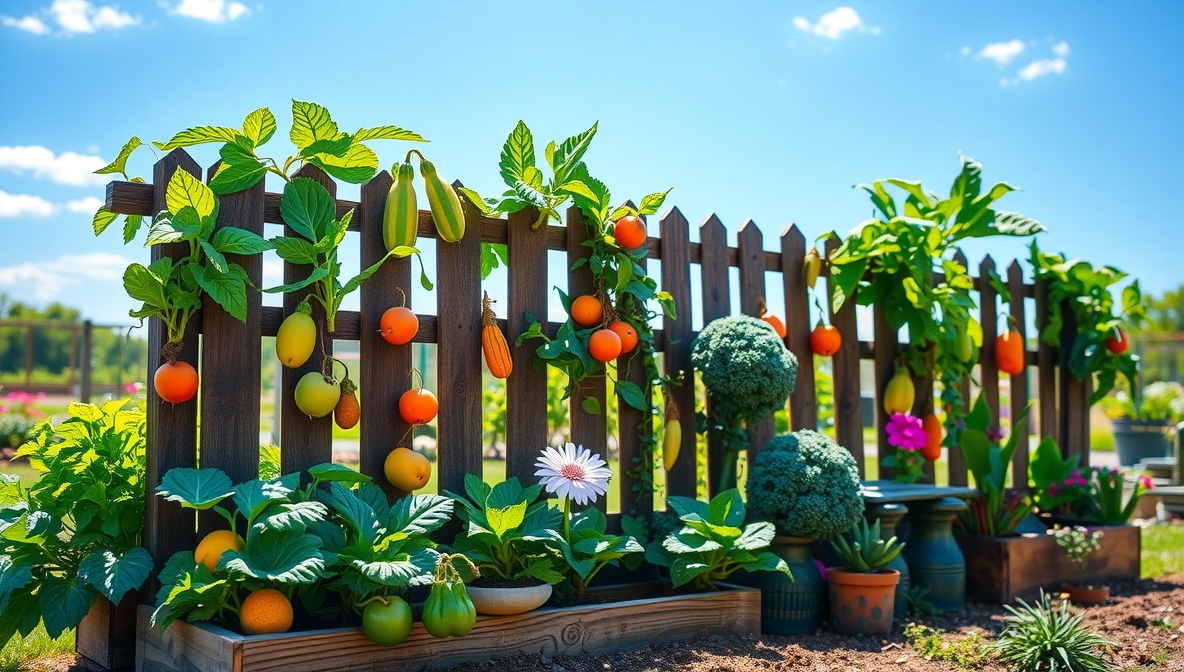
A thriving vegetable garden attracts more than just admiration—it draws curious critters, nosy neighbors, and sometimes a rogue soccer ball from next door. A sturdy fence does more than keep your veggies safe; it sets the tone for your garden’s personality. From rustic wood panels to upcycled treasures, a well-crafted garden fence adds charm and character while serving a vital purpose.
Many gardeners overlook fencing until pests have already claimed their prize. Smart design helps you stay ahead. A fence doesn’t need to be expensive or complicated to be effective. Scrap lumber, chicken wire, reclaimed pallets, or even bike wheels can become part of your garden’s defense system. The right materials, assembled with intention, can protect your crops while showcasing your creativity.
Every garden tells a story. The fence you build can say a lot about your gardening style—practical, whimsical, modern, or eco-conscious. Whether you’re keeping out deer or adding a decorative border around raised beds, thoughtful DIY ideas offer solutions that suit every space and skill level. Discover inspiring ways to frame your harvest and build a boundary that works as hard as you do.
DIY Vegetable Garden Fence Ideas
A good fence keeps animals out and gives your garden a neat look. It can also make your garden feel more like part of your home. Building one doesn’t need to cost much or take a lot of time. These ideas use simple materials. Most of them only need basic tools. You can do these projects in a weekend.
Here are 10 smart and easy DIY vegetable garden fence ideas. Each one includes the materials and simple steps to help you build it.
1. Wooden Picket Fence
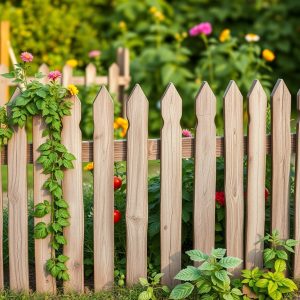
Materials:
- Wooden pickets
- 2×4 wooden rails
- Fence posts
- Nails or screws
- Drill or hammer
- Saw
Steps:
- Mark the garden boundary with string.
- Dig holes for fence posts, about 6 feet apart.
- Set posts in concrete or tightly packed soil.
- Attach horizontal rails between the posts.
- Nail or screw pickets to the rails, spacing them evenly.
- Paint or seal the wood to protect it from weather.
This fence gives a classic look. It’s strong enough to keep out rabbits and small pets.
2. Chicken Wire Fence
Materials:
- Wooden stakes or metal T-posts
- Chicken wire
- Staple gun or wire ties
- Wire cutters
- Mallet or post driver
Steps:
- Place stakes around the garden every 5-6 feet.
- Use a mallet to drive them into the ground.
- Unroll the chicken wire.
- Attach it to each post using a staple gun or wire ties.
- Make sure the bottom of the wire touches the ground.
- Bend the base outwards to stop digging animals.
It’s cheap and fast to build. Great for small animals like rabbits and squirrels.
3. Bamboo Fence
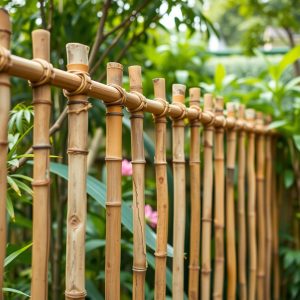
Materials:
- Bamboo poles
- Twine or zip ties
- Wooden or metal stakes
- Pruners or saw
Steps:
- Cut bamboo poles to your desired height.
- Place stakes around your garden.
- Tie bamboo poles to the stakes with twine or zip ties.
- Keep the poles close together for a solid wall.
Bamboo gives a natural look. It blends with plants and works well for small gardens.
4. Pallet Fence
Materials:
- Wooden pallets
- Saw
- Drill
- Screws or nails
- Fence posts (optional)
Steps:
- Collect old pallets from stores or friends.
- Cut them to the height you want.
- Place them in a row around your garden.
- Screw or nail them together.
- Secure with fence posts if needed.
Pallet fences are easy to find and free in many places. They make strong and wide barriers.
5. Wire and Wood Frame Fence
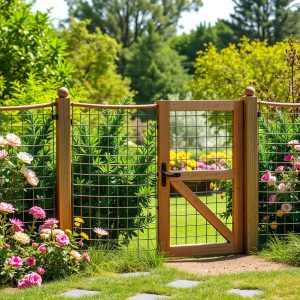
Materials:
- Wire mesh
- Wooden boards (2×4)
- Hinges and latch (for gate)
- Screws
- Saw
- Drill
Steps:
- Build wooden frames for each panel.
- Staple wire mesh to each frame.
- Attach panels to posts.
- Create a gate using the same frame style.
- Add hinges and latch to the gate.
This style is clean and modern. It gives clear sightlines and strong protection.
6. PVC Pipe Fence
Materials:
- PVC pipes (1 inch thick or more)
- PVC connectors
- Chicken wire or mesh
- Zip ties
- Pipe cutter
Steps:
- Cut PVC pipes to the needed lengths.
- Build a square or rectangle frame using connectors.
- Wrap chicken wire around the frame.
- Attach wire with zip ties.
- Push the base into the ground or attach to stakes.
PVC is light and easy to move. This works well for seasonal gardens.
7. Recycled Door or Window Fence

Materials:
- Old wooden doors or window frames
- Hinges (optional)
- Screws or nails
- Drill
Steps:
- Collect similar-sized doors or windows.
- Line them up around the garden.
- Connect them using hinges or screw into posts.
- Add a latch if you want a working gate.
It adds charm and character. Great for cottage-style gardens.
8. Rope and Post Fence
Materials:
- Wooden posts
- Thick rope
- Drill
- Sandpaper
- Paint or sealant (optional)
Steps:
- Space posts around your garden.
- Drill holes through the posts at even heights.
- Thread rope through the holes.
- Tie knots to keep it from sliding.
- Seal the posts for longer life.
This works more as a visual barrier. It won’t stop animals but can show clear borders.
9. Living Fence with Trellis
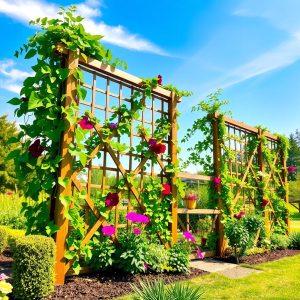
Materials:
- Wooden trellis panels
- Climbing plants (beans, peas, cucumbers)
- Wooden stakes
- Twine
- Screws
Steps:
- Place trellis panels around the garden.
- Secure them with stakes.
- Plant climbing veggies at the base.
- Tie new growth to the trellis.
It offers beauty and food at once. Saves space and looks green all season.
10. Log Fence
Materials:
- Small logs or thick branches
- Axe or saw
- Hammer
- Wooden stakes
Steps:
- Gather fallen logs or branches.
- Trim to similar lengths.
- Stack logs in a row around the garden.
- Drive stakes into the ground behind the stack.
- Use nails or rope to hold logs in place.
This fence uses what nature gives. It looks rustic and costs very little.
FAQs
How high should a vegetable garden fence be?
Most fences should be at least 2 to 3 feet tall. For deer, go higher—about 6 to 8 feet.
What fence keeps rabbits out best?
Chicken wire or wire mesh works well. Bend the bottom outward to stop digging.
Can I build a garden fence without tools?
Some fences, like bamboo or pallet types, need only a few tools. You can also tie or stack materials.
Is a fence needed for every garden?
No. But it helps if you have pests or pets. It also keeps plants safe from damage.
What is the cheapest fence option?
Chicken wire with wooden stakes or bamboo is low cost. Pallets are also free in many places.
Conclusion
A DIY vegetable garden fence does more than keep animals out. It shapes your garden, adds style, and protects your hard work. The best part? You can build it with basic tools and materials. Use wood, wire, PVC, or even old windows. Each idea brings its own charm.
Pick a style that fits your space and needs. Then get started. Your garden will thank you.
